As long as we're on a history kick, I thought I'd share this Time magazine article from 1964 about Ara. It's terrific. Quite a few parallels between then and now...see how many you can find.
Nov. 20, 1964
Toilet-paper streamers festooned the trees. Strings of firecrackers chattered like machine guns. Signs were everywhere. SONS OF ERIN, UNITE! they said. RUB THEIR NOSES IN THE IRISH SOD! Sturdy young men stopped strangers, flashed their "Hate State!" buttons and inquired politely: "You wouldn't be a State man, now, would you?" South Bend, Ind., was no place for the faint of heart last week. Notre Dame, the No. 1 college football team in the nation, was taking on Archrival Michigan State—and the Fighting Irish were in a fighting mood.
The Irish had not beaten State in ten years; inside the Notre Dame stadium, Athletic Director Edward ("Moose") Krause surveyed the sellout crowd of 59,265 and sighed: "We could have sold 250,000 tickets to this game." He could have sold a million—to all the Americans, the vast Subway Alumni, to whom Notre Dame is and always has been the one and only college football team.

To the Bronx taxi driver who has never seen the inside of a college but lights a candle to Our Lady every Friday night. To the San Francisco dock walloper who hasn't the foggiest notion where South Bend is but knows every player on the Irish squad. To the nuns in convents, whose radio-side prayers on Saturday go something like this: "God's will be done . . . but please let Notre Dame win." And what about the two Indiana priests who walked into a polling booth last Nov. 3 and wrote in the name of Ara Parseghian for President?
On His Knees. Down beneath the stands, wearing his lucky brown trousers and a blue sweater with NOTRE DAME lettered across the front, the Subway Alumni's candidate stood in the middle of the noisy locker room. "Everybody stay where you are!" he yelled. Then, pounding his fist into his palm, Ara Raoul Parseghian, 41, began to talk. "Boys (bang), you read the newspapers (bang). The predictors (bang, bang) say Michigan State is going to beat us. But we (bang) are a better team than they are. We're going out there (bang) and prove it (BANG)!" Then, along with the rest of the Fighting Irish, Coach Parseghian, a French-Armenian Protestant, sank to his knees and bowed his head. "Hail Mary, full of grace . . ."
Sportswriters had billed it "the game of the year." It was that—for Notre Dame and for the 35 million fans watching on nationwide TV, the millions more clustered around radios in bars and stores and barbershops. A good game might have been enough; a narrow victory would have sent them into ecstasy. What they got was beyond their wildest dreams.
In the next two hours, a great team systematically took a good team apart. Michigan State did not get a first down until it was two touchdowns behind. Only twice in the whole first half did a Notre Dame running play fail to gain. First it was Halfback Nick Eddy, spinning off tackle on the second play from scrimmage, racing 61 yds. for a TD—while Coach Parseghian matched him step for step, shouting "Go! Go! Go!" Then it was Fullback Joe Farrell, cracking the Spartan line on three straight plays for 15 yds. On the fourth play, he faked a line buck and zigzagged downfield to take a pass from Quarterback John Huarte. That put the ball on the Michigan State eight. Another Farrell fake, another Huarte pass—touchdown.
Ara Parseghian prowled the sideline, lips peeled back over his teeth. "Pursuit! Pursuit!" he screamed at the Notre Dame defense, and again Michigan State had to give up the ball. "More! More!" he yelled at the offense, and again the relentless Irish began to march. The massive (219 lbs. per man) Notre Dame line ripped gaping holes in the Spartan forward wall, gave Quarterback Huarte so much protection that he could have tied his shoe laces and still had time to pass. A screen to End Jack Snow gained 19 yds., a flare to Fullback Bob Merkle picked up 26. Then he turned Nick Eddy loose. In five carries, the 195-lb. halfback racked up 40 yds. and his second TD of the day. A pass to Snow was good for two extra points, and Notre Dame led at half time 20-0.
Anything & Everything. Back came the two teams, and the excitement leaped a notch. Desperate now, the Spartans tried anything—and for a while everything worked. They shifted from the T into a short punt formation and drew the Notre Dame line off side. They caught the Irish secondary napping, with a 51-yd. pass that cut the gap to 20-7. Luck helped a lot: two Notre Dame touchdowns were nullified. But now the aroused State defense was starting to harry Huarte. Somehow he still managed to get the ball away—sidearm, underhand, any way at all. And when he couldn't pass, he ran like a halfback—ripping out of the grasp of three tacklers for 21 yds. and a touchdown that made it 28-7. After that, the spectators stole the show. Twice, play was stopped while the sheriff's deputies chased fans around the field. That was enough to frighten even Parseghian. Off came the first team; in went the subs. Another Irish touchdown. Final score: Notre Dame 34, Michigan State 7.
The victory was doubly sweet because it was the sort of thing that wasn't supposed to happen in 1964—and did anyway. It was the season of surprises, the year the experts all guessed wrong. This was the year a Penn State squad that lost four out of its first five clobbered unbeaten Ohio State 27-0, the year Texas did not win the Southwest Conference championship, the year mighty Mississippi had to settle for a tie with weak little Vanderbilt. It was the year free substitution and the platoon system came back to college football—if the coaches were willing to take penalties to get their subs into the game. It was the year collegians outdrew the pros—when attendance in the Big Ten averaged 59,000 a game to 49,000 in the National Football League. And, most of all, this was Ara Parseghian's year, the year a restless vagabond from Ohio took over a demoralized Notre Dame team that had spent five years forgetting how to win—and taught them how again.
It all started innocently enough, with a 31-7 victory over Wisconsin. But when Notre Dame licked Purdue to the tune of 34-15, people began to wonder, including Purdue Coach Jack Mollenkopf. "They're big," warned Mollenkopf, "as big as the pros." As victory piled on victory, so did the pressure. Everybody was laying for Notre Dame. Air Force leaped into a 7-0 lead on an intercepted pass. Notre Dame still won 34-7. "That line," sighed Falcon Coach Ben Martin. "At first they came like a wave and pushed the blockers back into our quarterback's lap. Later they just picked them up and threw them back." U.C.L.A. Coach Bill Barnes thought he knew a way to beat the Irish. "Play for breaks." Barnes should have said a couple of Hail Marys. Notre Dame won 24-0.
Brokenhearted. Stanford was next: the Indians did not reach midfield in the whole first half, did not get a first down until 7 min. into the second, and fell 28-6. But one tearful Irish lineman was still dissatisfied: "I was really brokenhearted when they got that touchdown," he said. Fully recovered from an early-season injury, Navy's brilliant Quarterback Roger Staubach did his best to stop the Irish rampage —with 19 completions in 36 pass attempts. But Notre Dame's Huarte completed ten of 17 passes, and the score was the measure of the teams: Notre Dame 40-0.
After that, Pittsburgh figured to be easy pickings. The Panthers had won only two games all season. When Notre Dame scored two quick touchdowns—one on a pass from Huarte to Halfback Nick Eddy that covered 91 yds. it looked like a rout. But then everything went wrong. Halfback Bill Wolski fumbled on the Pitt two, and Snow dropped a pass on the Pittsburgh goal line. Banging away at the Irish line, Pitt picked up 199 yds. rushing—16 yds. more than all six of Notre Dame's previous opponents lumped together. Finally, it was the fourth quarter, and Pitt had the ball, fourth down and one on the Notre Dame 16. Pitt gambled on making the yard. The Irish held and eked out a 17-15 victory.
"Well," said Parseghian, "at least we won." With Michigan State out of the way, the Irish led the nation in rushing defense (63 yds. per game), ranked second in total offense (409 yds. per game), fourth in passing. Now, Iowa (season's record: 3 wins, 5 losses) and Southern Cal (5-3) were the only obstacles remaining in Notre Dame's path to the national championship and its first umblemished season in 15 years.
Ara Parseghian was not cheering yet. "With the kind of schedules you play today," he gloomed, "it's almost impossible to go through a season undefeated." But from Scollay Square to Fisherman's Wharf, the Subway Alumni, who thought anything was possible, sang still another chorus of the most famous fight song in the land:
Cheer, cheer for old Notre Dame.Wake up the echoes cheering her name.Send a volley cheer on highShake down the thunder from the sky.What though the odds be, great or small,Old Notre Dame will win over all,.While her loyal sons are marching Onward to victory."Dear Sir." The nation's best-known football foundry is a Johnny-come-lately to the game. The University of Notre Dame was barely out of the log-cabin stage when Rutgers and Princeton played the first intercollegiate football game in 1869. The Fighting Irish had a school cheer in 1879 ("Rah, rah! Nostra Domina"), but they did not have a team to cheer for until 1887—eight years after the famed Golden Dome of Our Lady first cast its glint across the Indiana plains. It wasn't much of a team at that; in two years, Notre Dame lost three straight to Michigan, prompting the coach to dash off a plaintive letter to Yale's Walter Camp: "Dear Sir: Will you kindly furnish me some points on the best way to develop a good football team?" Whatever Camp's advice was, it worked: the Irish were unbeaten m 1892 and 1893; and in 1903, they ran up 292 points to their opponents' zero.
They also began to run out of opposition. Schools in the Intercollegiate Conference (today's Big Ten) flatly refused to play them, and the frustrated Irish had to content themselves with belting the likes of Franklin (64-0), Loyola of Chicago (80-0) and St. Viator (116-7). In 1913, casting around for games. Coach Jesse Harper hooked a whopper Old Rivals Harvard and Yale had dropped off Army's schedule because the Cadets refused to sell tickets to their games. Desperate for a "filler" Army agreed to a $1,000 guarantee, and Harper's eager Irish headed East. Undefeated in four games, Army was a powerhouse—and there were chuckles all around when somebody discovered that the visitors had 18 players but only 14 pairs of cleats. Army was the overwhelming favorite: its line outweighed Notre Dame by 15 lbs. per man. and fans were so sure the game would be a slaughter that only 3,000 bothered to turn out.
The Rock. It was a slaughter all right—just like David and Goliath. In those days football was a mannerly game: teams were expected to punt on first down inside their own 20-yd. line and never, never throw a forward pass. The upstarts from Indiana punted only on fourth down—and passed the Cadets goggle-eyed. In one fantastic flurry. Quarterback Gus Dorais completed 12 in a row. His main target was a balding bandy-legged end named Knute Kenneth Rockne, who at 5 ft. 8 in. and 145 lbs. was probably the smallest man on the field. Army defenders could not help admiring Rockne's courage; the game had barely started before he was limping noticeably. Late in the first period, with the ball on the Army 30 Dorais dropped back to pass. Nobody noticed Rockne, hobbling painfully down the sideline. Suddenly, the limp disappeared; he was running full tilt toward the Army goal, reaching up for the pass. Touchdown! Before the long afternoon was over, Notre Dame's passing attack had clicked for 243 yds. and two TDs, and the unknown Indiana school had upset mighty Army 35-13.
It had to be foreordained that Rockne would return as coach. And there he was in 1918, the son of a Norwegian carriage maker, carving his name as one of the game's enduring geniuses. He pioneered the platoon system, perfected the forward pass, lifted (so the famous story goes) the Notre Dame "box shift" from the routine of a dance-hall chorus line. His teams traveled from coast to coast and South to the Gulf, playing 122 games and winning 105 over 13 seasons. Five times they were unbeaten; three times they won the national championship.
They called themselves Irish, but only a healthy handful were. Poles, Germans, Italians, Catholics, Protestants, Jews, everyone flocked to South Bend. One September, 90 high school captains turned out for the freshman team. No school in football history produced such stars: Frank Carideo, Marchy Schwartz, Johnny O'Brien and the incomparable George Gipp—Notre Dame's first All-America, who drop-kicked a 62-yd. field goal in his first college game, gained 332 yds. against Army, and died of pneumonia at 25. There was the "pony backfield" of 1924 that averaged 158 lbs. per man and won immortality on the typewriter of Grantland Rice: "Outlined against a blue-grey October sky, the Four Horsemen rode again. In dramatic lore they are known as Famine, Pestilence, Destruction and Death. These are only aliases. Their real names are Stuhldreher, Miller, Crowley and Layden."
Then there was Rockne himself, the master psychologist who once ran the Four Horsemen behind a third-string line and shouted from the sidelines, "Show 'em your clippings! Show 'em your clippings!" He was the sly pessimist who advised, "Never tell 'em how many lettermen you've got coming back. Tell 'em how many you've lost." He was the locker-room orator who called his team together before the 1928 Army game and talked about George Gipp—his perfection, his ability to come through in the clutch, and his deathbed request: "Sometime, when things are going wrong and the breaks are beating the boys, tell them to go in there with all they've got and win one just for the Gipper. I don't know where I'll be then, Rock, but I'll know about it and I'll be happy." Notre Dame beat Army 12-6. But that was hardly surprising to Rockne: it had worked the first time he tried it-seven years before.
The Robot. Rockne died in a plane crash in 1931, and for a while it looked as if Notre Dame's football fortunes were riding the same plane: the Irish experienced their first losing season in 45 years. But in 1941, Notre Dame got a new coach—an Irishman, yet—and the leprechauns became giants again. Tough and tightlipped, Frank Leahy had nothing in common with Rockne except a ferocious desire to win all the time. His players called him "The Robot," and he drove them mercilessly. "I want to see blood on the quarterbacks' hands when you snap the ball," he told his centers. Rival coaches ac cused Leahy of teaching "dirty football," of flagrant recruiting violations, of "twisting" the rulebook with his "sucker shifts" and faked injuries. But one thing nobody could argue with: his success. With such stars as Johnny Lujack, George Connor, Johnny Lattner, Leon Hart and Ralph Guglielmi, Leahy won four national championships, ran off a string of 39 games without a loss, retired in 1953 with an overall record of 87 wins, eleven losses, nine ties.
After Leahy, the deluge. Terry Brennan took over as coach, did reasonably well (32 wins, 18 losses)—except by Notre Dame standards—and gave way to Joe Kuharich in 1959. Kuharich, a top pro coach with the National Football League's Washington Redskins, was no improvement. Over two seasons, 23 of his players had to be operated on for knee injuries. What's more, Notre Dame's president, the Rev. Theodore M. Hesburgh (TIME cover, Feb. 9. 1962), was determinedly hauling up the school's academic standards, saw no reason to grant exemptions to football players. The upshot: Kuharich lost 23 out of 40 games, quit in 1962 to go back to the pros (he now coaches the Philadelphia Eagles). Finally, last year it was poor Hugh Devore's turn: he reluctantly agreed to fill in for one year as "interim" coach—and suffered through a dismal 2-7 season.
Football had not really been de-emphasized at Notre Dame; it had de-emphasized itself. In the golden years of Rockne and Leahy, the $500,000-a-year take from football paid faculty salaries, built dormitories and a stadium. Now, when the cost of Notre Dame's sports program was deducted, there was barely enough left over to pay the coal bill for an Indiana winter. The Irish still wanted a winning team —"We are dedicated to excellence," said the Rev. Edmund Joyce, Notre Dame's executive vice president—but not enough to pay for it. The school awards only 30 football scholarships a year, and they are strictly limited to board, room and tuition—no "walking-around money." Under those ground rules, what coach would gamble his reputation? What coach indeed—except Ara Parseghian?
"I'm the Greatest." The wonder is that it took him so long to get to South Bend. Handsome and raven-haired, Parseghian could pose for anyone's image of the spirit of Notre Dame—wearing Leahy's shoes and Rockne's suit. He has to win because the laundry bill is too high when he loses; his wife has to change the sweat-soaked bed sheets each morning. Navy Coach Wayne Hardin delights in telling of playing partners with Parseghian in a golf match a few summers ago: "We came up to the 18th hole and had to win it to take the match. Ara stuck one on the green, about 40 ft. from the pin. He stepped up to putt, paused and asked: 'What state are we in?' 'We're in Pennsylvania,' I said. 'All right,' said Ara. Then I'm the greatest putter in the state of Pennsylvania.' He swung and, sure enough, the ball went over four or five breaks plunk into the cup."
It stands to reason that Parseghian must have been a beautiful baby. His father named him after a mythological Armenian king named "Ara the Beautiful," and his mother kept him in dresses until he was six. As soon as he graduated to pants, he started sneaking off to play tackle football with the older kids in Akron, and the only way mom could get him home was to come after him with the sawed-off broomstick she used to stir the family wash. As an eighth-grader, Ara was everybody's nomination for Toughest Kid in school—even the Board of Education's. "They were having a lot of trouble with vandals breaking windows," recalls Older Brother Gerard, 43, a Toledo businessman. "So they just hired Ara to patrol the grounds. The checks came directly from the Board of Education. He was real proud of that."
At South High School, Parseghian is remembered as a kind of Jack Armstrong with Wheaties coming out his ears. "He worked like the dickens for his S," a classmate recalls. "If he saw somebody wearing a letter who hadn't participated in athletics, he'd take it away from him and tell him to turn out for the team." Ara's mother was violently against football; whenever she went to a game, she spent the afternoon hiding under the stands, praying for Ara's safety. It would have been kinder to pray for the other fellow. South High Coach Frank ("Doc") Wargo remembers one encounter against Steubenville High, an Ohio Valley team made up mostly of miners' sons. "Ara was tough. But Steubenville had a tough fullback too. On the first play from scrimmage, the two of them met headon, and you could hear the helmets crash. Both boys went down. After a few seconds, Ara jumped up. They carried their fullback out."
Call Him Hardnose. Parseghian enrolled at the University of Akron, spent two wartime years in the Navy: then back to football he went, this time at Miami of Ohio, a small school with an uncanny knack for producing big-time coaches—Army's Earl Blaik and Paul Dietzel, Ohio State's Woody Hayes, the pros' Paul Brown, Weeb Ewbank and Sid Gillman. In 1947, a solid 190-lb. halfback, Ara led the Redskins to an undefeated season, won All-America mention and a pro tryout with the Cleveland Browns.
"Hardnose" was the Browns' name for him, for the fierce way he slammed into blitzing enemy linemen. He had a bad ankle, but he was still Coach Paul Brown's regular halfback. "He'd hurt it and I'd take him out of the game," remembers Brown, "and next thing you know, he'd be limping up and down the sidelines until he could walk on it again. Then he'd beg me to put him back in."
In 1949, another injury ended Parseghian's playing career permanently. Flicking through an opening in the Baltimore Colts' line, he cut to avoid a linebacker, sprawled headlong with a badly torn cartilage in his right hip. His hip has never been quite right since, and he is bothered by occasional arthritis.
Married, out of work, Parseghian went looking for a job. "There was only one thing Ara didn't want to do," says his brother Gerard, "and that was coach. He thought coaches had to be nuts to put up with the stuff they did." But when Miami Coach Woody Hayes offered him the freshman team, Parseghian leaped at the chance. Then everything happened at once. The frosh team went undefeated. At season's end Hayes packed off to Ohio State. And at 27, Ara Parseghian became the youngest head coach in Miami's history. "I thought you said all coaches were nuts," smirked Gerard. Sighed Ara, "Buddy, I've got the bug."
In five years Parseghian won 39 games, lost only six—and two of those victories came at the direct expense of the powerful Big Ten. In 1954, the day before Miami was scheduled to play Indiana, he deliberately dressed the Redskins in tattered old practice uniforms, sent them through a ragged workout before the eyes of the grinning Hoosiers. Next day, faultlessly attired in new uniforms, Miami upset Indiana 6-0. Frank Leahy would have approved. Next year, against Northwestern, Parseghian even sought out Rival Coach Lou Saban to plead for mercy. Saban, says a Parseghian associate, "really swallowed all that stuff." Miami upset the Wildcats 25-14, and at season's end Saban was out of a job. Who was in? Parseghian, of course.
"They'll See You." When Parseghian arrived in 1956, things were so bad that Northwestern's student newspaper was calling for the school to withdraw from the Big Ten. Northwestern had lost 27 of its last 31 conference games, had not won any game at all in 1955. The only private school in the Big Ten, Northwestern's entrance requirements were the highest in the league, while its men's enrollment (3,936) was the smallest. Why not call it quits? Snarled Parseghian: "If I thought that way, I wouldn't be here. All right, maybe it's an obsession thinking we can do what everyone says is impossible. But we can win." No U.S. Marine recruiting officer ever crooned a smoother pitch. To Chicago high school athletes who thought about going away to school, he said: "Your future business contacts are here in Chicago. They'll see you out there, they'll know all about you."
The Wildcats never wound up higher than third in the Big Ten, but there were plenty of moments to savor: a 21-0 victory over Ohio State that ended the Buckeyes' 14-game unbeaten streak, the 45-13 crushing of Bud Wilkinson's Oklahoma team on nationwide TV-and the four straight victories over Notre Dame that, more than anything else, convinced the Irish that Parseghian was the man to put a new coat of gold on the dome.
In the Spotlight. Parseghian's move to South Bend last January was more like a homecoming than an arrival. He was introduced between halves of a basketball game, and the students gave him a ten-minute standing ovation. In mid-February, 3,000 turned out in two feet of snow for a mammoth pep rally. If it was spirit they wanted, spirit he gave them. At spring training he whipped out a letter written by a former Notre Dame player who had been seriously injured in an auto accident. Rockne couldn't have done it better. Voice quavering, Parseghian read the letter to the spellbound team: "Being a Notre Dame football player automatically puts you in the national spotlight, more so than players from any other school. Don't let those fans down. Be honest with yourself. Give that second and third effort. Bring Notre Dame football back where it belongs."
The spirit might be willing, but it takes a powerful amount of flesh to make a football winner—and the most optimistic experts did not figure Notre Dame for much this year. The school hadn't had a winning season in five years; 22 out of 38 lettermen had graduated from last year's squad that lost seven of its nine games. Parseghian rebuilt the team as though he were running a fire sale.
Out went Notre Dame's old uniforms and pads ("too heavy," he said), replaced by new lightweight gold pants, plain blue jerseys, and helmets whose color was keyed exactly to the Golden Dome itself. Out went the old split T formation, with its quarterback keepers, replaced by the pro-style slot T and the dazzling stacked I—in which three backs line up in a straight line behind the center, then shift suddenly to one side or the other. Out, too, went the old system of calling signals in the huddle. "In the pressure of the game," explains Parseghian, "you don't have time to listen to somebody yell '32' and ponder which hole is the three hole and which back is the two back.

We just describe our plays in the most accurate way possible—like 'power sweep right,' or 'belly sweep left.' And we haven't had a badly busted play all season."
In spring training Parseghian wandered around the field like an Arab horse trader. He spent hundreds of hours studying last year's game films, analyzing each man's potential. Finally one day he sauntered up to John Huarte, a quiet Californian who had played just 50 minutes of football in two years, and said: "John, you're my quarterback for the season. I don't care if you throw six interceptions in the first game. You're my quarterback. You're gonna live with me ten weeks this fall." Parseghian's next visit was with Jack Snow, the 6-ft. 2-in., 215-lb. end whom he had singled out as Huarte's No. 1 passing target. Between them, Huarte and Snow have already broken practically all of Notre Dame's season passing records.
Finally, there was Linebacker Jim Carroll, a 225-lb. Georgian who was to be the key man in Parseghian's prostyle 4-4-3 defense. Last year Carroll was credited with 59 tackles; this year he has already made 120, to lead the team. He shrugged off a painful knee injury to stack up a last-ditch Pitt drive two weeks ago, and he was easily the angriest man on the squad last week when newsmen suggested the possibility of Michigan State's upsetting the top-ranked Irish. Maybe that's because he is Irish. "Listen," he growled. "We're No. 1. I've played with losing teams all my life, and nobody's going to take No. 1 away from me."
Nobody is going to take it away from Ara Parseghian either—not if the everliving, ever-loving spirit of Notre Dame can help it. On a "Clobber Board" in the Notre Dame locker room, messages supposedly sent by rival teams are posted to stoke the fires of effort. "Your luck has run out," read one signed The Panther. "I will beat you this Saturday because I am bigger and stronger and meaner than you are." Everywhere the team goes, the coach goes—instructing, cajoling, just being there to keep an eye on everything. After the Wisconsin game, Parseghian told his wife Kathleen not to meet him at the airport—"I want to go with the team to the campus." Before the Navy game in Philadelphia, local Notre Dame alumni had a motorcade all arranged to whisk Irish officials from the airport to the hotel. Parseghian turned down the car, insisted on riding in the team bus.
For Ara Parseghian, the man who cannot stand to lose, the day begins at 5:30 a.m. with four cups of coffee, usually ends with a tranquilizer and the Late Late Show. Even when he eats, he has a pencil in the other hand, diagramming a play. Is there something he has forgotten, some minuscule detail he has overlooked, some new way to win? There has to be, there always is at Notre Dame. Last week, bone-weary, he paused in Memorial Building to confront a bust of Knute Rockne. "You," he said softly. "You started all this."

To be fair, this goes on all over. Notre Dame didn't invent human hamster ball racing, but that's no excuse for neutralizing its home court with a glorified carnival ride that falls as flat as a participant who doesn't watch his step.

 The addition of Schmidt to a backfield already consisting of speedy Munir Prince and versatile James Aldridge gives this recruiting class a loaded group of ball carriers, each with a slightly different skill set. Notre Dame has told Schmidt he will fill a fullback/tight end/H-back role, which basically means he will be lining up in multiple spots on offense. Adding to his versatility, Schmidt has lined up at wide receiver on occasion (which leads me to belive he doesn't have bricks for hands) and according to his coach will line up at linebacker this fall. And to top it all off, Purdue was recruiting him for defensive end as well as tailback.
The addition of Schmidt to a backfield already consisting of speedy Munir Prince and versatile James Aldridge gives this recruiting class a loaded group of ball carriers, each with a slightly different skill set. Notre Dame has told Schmidt he will fill a fullback/tight end/H-back role, which basically means he will be lining up in multiple spots on offense. Adding to his versatility, Schmidt has lined up at wide receiver on occasion (which leads me to belive he doesn't have bricks for hands) and according to his coach will line up at linebacker this fall. And to top it all off, Purdue was recruiting him for defensive end as well as tailback. "Hail Mary, full of grace, Notre Dame's in second place." None of that, however, was as bad as our arrival in East Lansing. As I disembarked, I noticed the metal steps were slippery with ice. Behind me, I heard a yelp. It was my roommate on the road, Nick Eddy. He'd slipped, missed his grab for the handrail, and reinjured his bruised shoulder. He was doubled over, crying with pain and with the instant realization that he couldn't play in the biggest game of his career. People called it "The Game of the Century" that year... which was not especially important, because somebody makes that statement about one game in nearly every college football season. What is significant is that even today, some experts are still calling it "The Game of the Century."
"Hail Mary, full of grace, Notre Dame's in second place." None of that, however, was as bad as our arrival in East Lansing. As I disembarked, I noticed the metal steps were slippery with ice. Behind me, I heard a yelp. It was my roommate on the road, Nick Eddy. He'd slipped, missed his grab for the handrail, and reinjured his bruised shoulder. He was doubled over, crying with pain and with the instant realization that he couldn't play in the biggest game of his career. People called it "The Game of the Century" that year... which was not especially important, because somebody makes that statement about one game in nearly every college football season. What is significant is that even today, some experts are still calling it "The Game of the Century." But Cagney had signed a petition in support of the anti-Catholic Republican government in the Spanish Civil War, and Notre Dame, having control over all aspects of the filming would not okay Cagney for the role.
But Cagney had signed a petition in support of the anti-Catholic Republican government in the Spanish Civil War, and Notre Dame, having control over all aspects of the filming would not okay Cagney for the role.
 Brown, Snow, Ismail, Theisman, Browner, etc...mostly people just taking wild stabs in the dark. Here's the complete list:
Brown, Snow, Ismail, Theisman, Browner, etc...mostly people just taking wild stabs in the dark. Here's the complete list:  I'm trying to think of an equivalent here...it's like Roy Hobbs disappearing from baseball for decades before coming back to the game, or maybe the
I'm trying to think of an equivalent here...it's like Roy Hobbs disappearing from baseball for decades before coming back to the game, or maybe the  In comparison, every NFL football game was played on Sunday, two days after the assassination. Many college football games were also played.
In comparison, every NFL football game was played on Sunday, two days after the assassination. Many college football games were also played. At one point we listed the question with four OT games, but then I checked my stack of polaroids and my
At one point we listed the question with four OT games, but then I checked my stack of polaroids and my  They formed the crest of the South Bend cyclone before which another fighting Army team was swept over the precipice at the Polo Grounds this afternoon as 55,000 spectators peered down upon the bewildering panorama spread out upon the green plain below."
They formed the crest of the South Bend cyclone before which another fighting Army team was swept over the precipice at the Polo Grounds this afternoon as 55,000 spectators peered down upon the bewildering panorama spread out upon the green plain below."








 To the Bronx taxi driver who has never seen the inside of a college but lights a candle to Our Lady every Friday night. To the San Francisco dock walloper who hasn't the foggiest notion where South Bend is but knows every player on the Irish squad. To the nuns in convents, whose radio-side prayers on Saturday go something like this: "God's will be done . . . but please let Notre Dame win." And what about the two Indiana priests who walked into a polling booth last Nov. 3 and wrote in the name of Ara Parseghian for President?
To the Bronx taxi driver who has never seen the inside of a college but lights a candle to Our Lady every Friday night. To the San Francisco dock walloper who hasn't the foggiest notion where South Bend is but knows every player on the Irish squad. To the nuns in convents, whose radio-side prayers on Saturday go something like this: "God's will be done . . . but please let Notre Dame win." And what about the two Indiana priests who walked into a polling booth last Nov. 3 and wrote in the name of Ara Parseghian for President? We just describe our plays in the most accurate way possible—like 'power sweep right,' or 'belly sweep left.' And we haven't had a badly busted play all season."
We just describe our plays in the most accurate way possible—like 'power sweep right,' or 'belly sweep left.' And we haven't had a badly busted play all season."






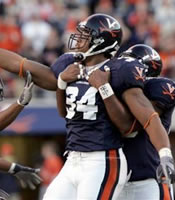


 Irish Heisman winner
Irish Heisman winner  "That's my other life," he said. "I haven't thought too much about college football."
"That's my other life," he said. "I haven't thought too much about college football." Freshly-painted golden helmets, glinting in the sun. Jerseys of deep, rich blues and stark, crisp whites: simple, unadorned but for a small interlocking ND, numbered yet nameless. Flat-finish pants, golden-brown, almost dun-colored. There is no better feeling for Fighting Irish fans than to be sitting in Notre Dame stadium on a fall afternoon waiting to see those pristine Golden Domes above navy blue jerseys emerge from the tunnel and run out onto the field. It's not just a game anymore, it's reliving
Freshly-painted golden helmets, glinting in the sun. Jerseys of deep, rich blues and stark, crisp whites: simple, unadorned but for a small interlocking ND, numbered yet nameless. Flat-finish pants, golden-brown, almost dun-colored. There is no better feeling for Fighting Irish fans than to be sitting in Notre Dame stadium on a fall afternoon waiting to see those pristine Golden Domes above navy blue jerseys emerge from the tunnel and run out onto the field. It's not just a game anymore, it's reliving  Very little research material is available on the very early Notre Dame uniform. The first ND team, in 1888, wore an all-white uniform with an "ND" written across the chest (right). It is around this time when the blue and gold colors became the official school colors. At the time of its founding in 1842, Notre Dame’s original school colors were yellow and blue; yellow symbolized "the light" and blue "the truth". However, sometime after the Dome and Statue of Mary atop the Main Building was gilded in 1886,
Very little research material is available on the very early Notre Dame uniform. The first ND team, in 1888, wore an all-white uniform with an "ND" written across the chest (right). It is around this time when the blue and gold colors became the official school colors. At the time of its founding in 1842, Notre Dame’s original school colors were yellow and blue; yellow symbolized "the light" and blue "the truth". However, sometime after the Dome and Statue of Mary atop the Main Building was gilded in 1886,  The 1900 team is pictured in a photo wearing uniforms that look anything but uniform (left). It's likely that there was no standard uniform during this time. ND at this time was fairly strapped for cash, and so players probably wore whatever was readily available to them (as a result, these guys look like extras from the cast of
The 1900 team is pictured in a photo wearing uniforms that look anything but uniform (left). It's likely that there was no standard uniform during this time. ND at this time was fairly strapped for cash, and so players probably wore whatever was readily available to them (as a result, these guys look like extras from the cast of  In 1914, ND coach
In 1914, ND coach 
 In the late 20’s, contests against Navy featured green-clad Notre Dame teams, to avoid confusion with Navy’s blue uniforms. Ever the innovator, Rockne began the tradition of using the green jersey as a psychological ploy, a strategy that would be copied by numerous Irish coaches in the years to come. When Notre Dame played Navy in Baltimore in 1927, Rockne started his second-string reserves. As the Midshipmen were scoring a touchdown in the first 5 minutes of the game, reported George Trevor in the New York Sun, Rockne made his move:
In the late 20’s, contests against Navy featured green-clad Notre Dame teams, to avoid confusion with Navy’s blue uniforms. Ever the innovator, Rockne began the tradition of using the green jersey as a psychological ploy, a strategy that would be copied by numerous Irish coaches in the years to come. When Notre Dame played Navy in Baltimore in 1927, Rockne started his second-string reserves. As the Midshipmen were scoring a touchdown in the first 5 minutes of the game, reported George Trevor in the New York Sun, Rockne made his move: The green uniforms also helped the Fighting Irish nickname gain momentum. The New York Herald-Tribune reported that when the team ran onto the field, the "Celtic representation" in the crowd "took to this display of green immediately and cheers from all their sections" arose.
The green uniforms also helped the Fighting Irish nickname gain momentum. The New York Herald-Tribune reported that when the team ran onto the field, the "Celtic representation" in the crowd "took to this display of green immediately and cheers from all their sections" arose. 

 Leahy was also quite fond of the green jersey and his squads wore it often, some years exclusively. Bertelli in ‘43 (below),
Leahy was also quite fond of the green jersey and his squads wore it often, some years exclusively. Bertelli in ‘43 (below), 









 During
During 

 There are at least 2 games where Ara’s squad wore jerseys with names on the back. The ’73 Sugar Bowl and the ’75 Orange Bowl featured the Irish clad in jerseys with names. The names are believed to have only been used in the bowl games since the names did not appear on in regular season games, such as ’73 USC.
There are at least 2 games where Ara’s squad wore jerseys with names on the back. The ’73 Sugar Bowl and the ’75 Orange Bowl featured the Irish clad in jerseys with names. The names are believed to have only been used in the bowl games since the names did not appear on in regular season games, such as ’73 USC. Ara did institute one unique change to the ND helmet; he handed out
Ara did institute one unique change to the ND helmet; he handed out 



 The 11th-ranked Irish were taking on 5th-ranked USC in another important battle between the two rivals. The spirited students made an enormous
The 11th-ranked Irish were taking on 5th-ranked USC in another important battle between the two rivals. The spirited students made an enormous 
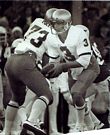

 With the arrival of
With the arrival of  The new Irish coach suggested some research into the University archives to determine the history of Notre Dame’s gold and blue colors.
The new Irish coach suggested some research into the University archives to determine the history of Notre Dame’s gold and blue colors. The away jerseys also had 3 stripes, two blue surrounding one gold. The stripes were eliminated on the ’84 tops, which didn’t feature any trim other than the white numbers on the navy blue shirts.
The away jerseys also had 3 stripes, two blue surrounding one gold. The stripes were eliminated on the ’84 tops, which didn’t feature any trim other than the white numbers on the navy blue shirts.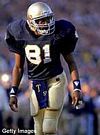
 Champion was the manufacturer of the uniform and in ‘92 they made a couple of additions to the
Champion was the manufacturer of the uniform and in ‘92 they made a couple of additions to the 



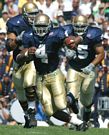 Under
Under  Notice that a small green shamrock was also added to the left front side of the pants, replacing the standard interlocking ND logo.
Notice that a small green shamrock was also added to the left front side of the pants, replacing the standard interlocking ND logo.  The American flag was added to the left shoulder and the back of the helmets in remembrance of the September 11th tragedy.
The American flag was added to the left shoulder and the back of the helmets in remembrance of the September 11th tragedy.
 The regular Adidas-made uniforms remained the same under Willingham until 2004 when they underwent several changes. The green shamrock and small script Irish were replaced with a small interlocking ND logo while the logo on the front of the pants was changed from green to blue. The ND logo on the shoulder sleeves was replaced with the number of the player and the gold flanks were finally removed from the away uniforms.
The regular Adidas-made uniforms remained the same under Willingham until 2004 when they underwent several changes. The green shamrock and small script Irish were replaced with a small interlocking ND logo while the logo on the front of the pants was changed from green to blue. The ND logo on the shoulder sleeves was replaced with the number of the player and the gold flanks were finally removed from the away uniforms.




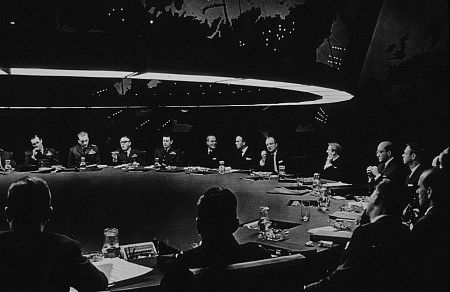





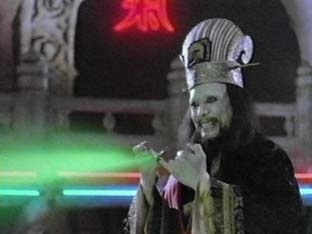
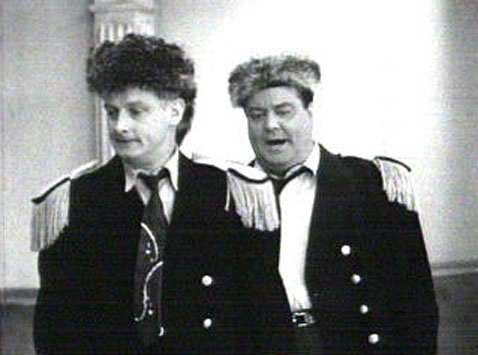 So the lodge meeting of the International Order of Friendly Sons of the Raccoons -- aka, the BCS -- just let out last week, emerging from a Phoenix resort in a haze of cigar smoke and the charred remains of C-notes wafting through the air. After the the hangover wore off, Cramden and Norton had some announcements for us.
So the lodge meeting of the International Order of Friendly Sons of the Raccoons -- aka, the BCS -- just let out last week, emerging from a Phoenix resort in a haze of cigar smoke and the charred remains of C-notes wafting through the air. After the the hangover wore off, Cramden and Norton had some announcements for us. Q: Do you see a suitable team for the Big Ten?
Q: Do you see a suitable team for the Big Ten? Well, as we've gotten accustomed to, the NFL draft came and went with only a small number of Irish players hearing their name called. This year it was only two: Justin Tuck and Jerome Collins.
Well, as we've gotten accustomed to, the NFL draft came and went with only a small number of Irish players hearing their name called. This year it was only two: Justin Tuck and Jerome Collins. The only other Irishman drafted was a bit of a surprise, given his lack of playing time while at Notre Dame: Jerome Collins went 144th in the 5th round to the St. Louis Rams. The Rams drafted him based on a pair of ESPN-cliche worthy labels that have unfortunately been affixed to Irish prospects over the past few years: "potential" and "upside". (Hopefully "production", "results", and "proven winner" are words we see more often in future Irish draft bios). He'll start out on special teams, where he made a mark this year with the Irish in blocking two punts, while he works on his game at tight end. But Collins doesn't seem to be
The only other Irishman drafted was a bit of a surprise, given his lack of playing time while at Notre Dame: Jerome Collins went 144th in the 5th round to the St. Louis Rams. The Rams drafted him based on a pair of ESPN-cliche worthy labels that have unfortunately been affixed to Irish prospects over the past few years: "potential" and "upside". (Hopefully "production", "results", and "proven winner" are words we see more often in future Irish draft bios). He'll start out on special teams, where he made a mark this year with the Irish in blocking two punts, while he works on his game at tight end. But Collins doesn't seem to be  As for the rest of the draft-eligible domers, all but one ended up signing a free agent contract with NFL teams, the lone exception being Kyle Budinscak, who according to anonymous internet posters, has opted to enter the business world. The
As for the rest of the draft-eligible domers, all but one ended up signing a free agent contract with NFL teams, the lone exception being Kyle Budinscak, who according to anonymous internet posters, has opted to enter the business world. The 
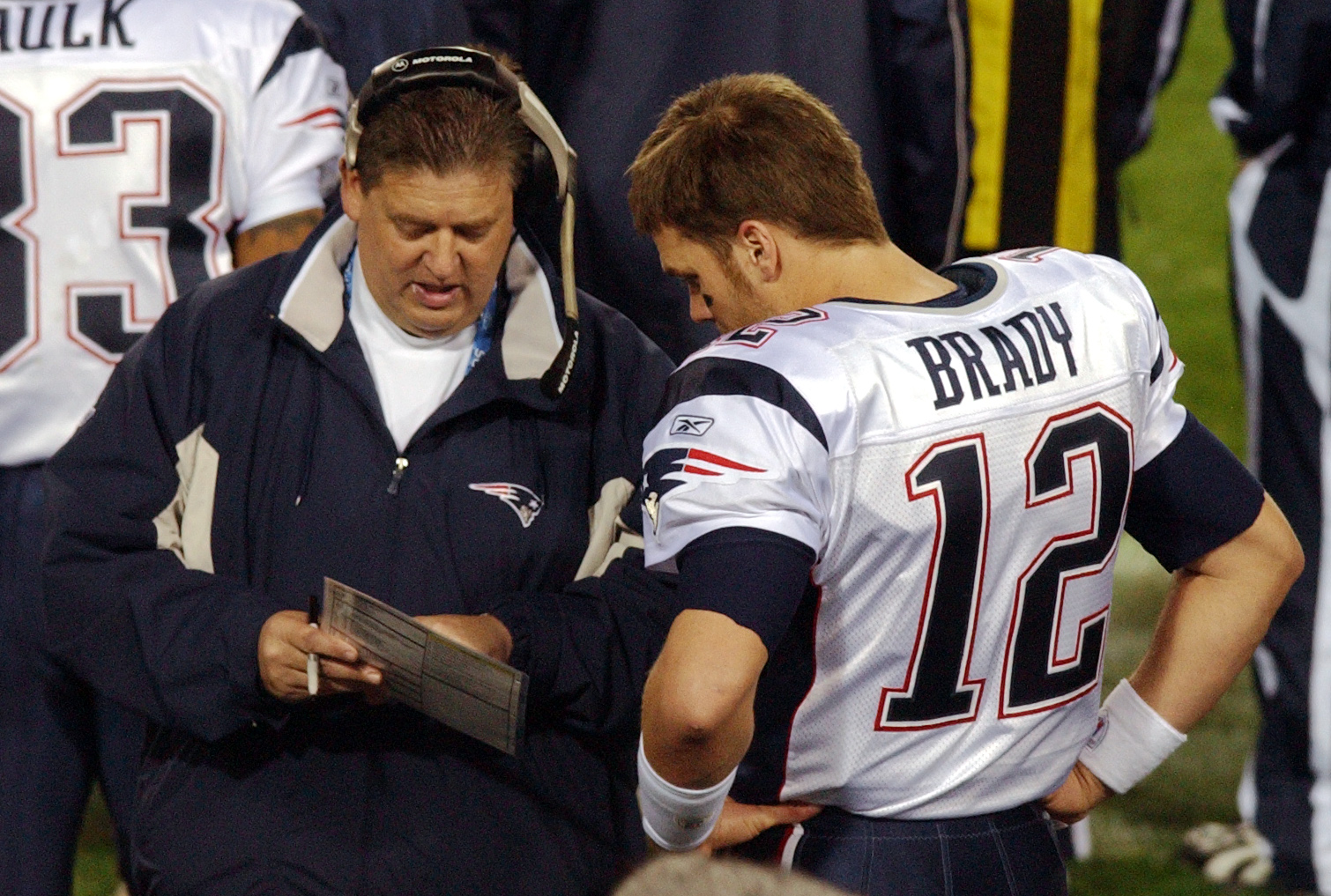

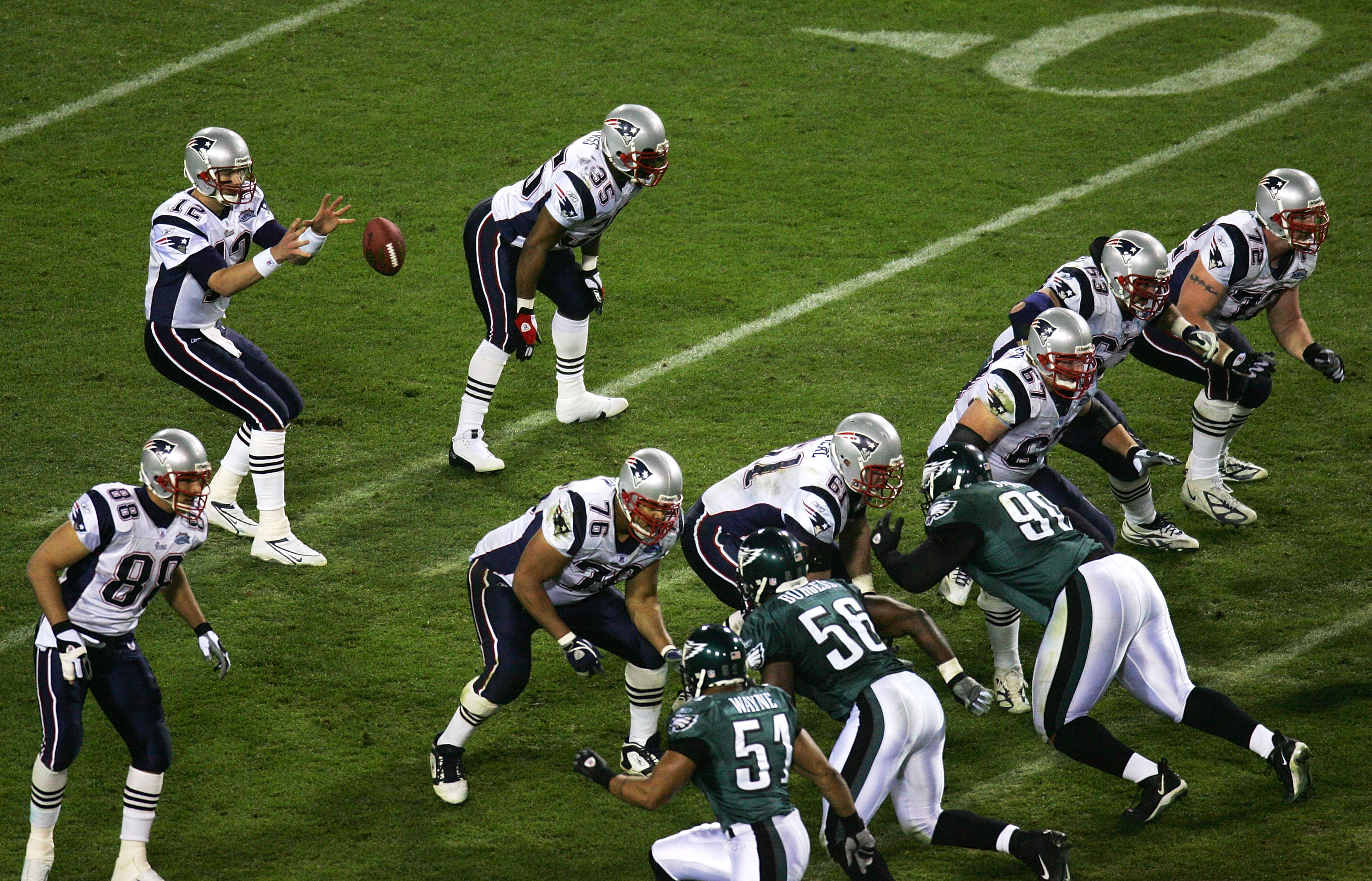 defense substitutes according to the offensive personnel on the field, and prepare against these patterns and tendencies.
defense substitutes according to the offensive personnel on the field, and prepare against these patterns and tendencies. "The more you can do with the same personnel group the better you are. When I went to Georgia Tech with George O'Leary, he used to talk about personnel groups being synonymous with formations. He thought like a lot of defensive coaches. He thought if you had two tight ends, one back and two wide receivers, you were going to be in that formation. I didn't understand that." Neither does Weis.
"The more you can do with the same personnel group the better you are. When I went to Georgia Tech with George O'Leary, he used to talk about personnel groups being synonymous with formations. He thought like a lot of defensive coaches. He thought if you had two tight ends, one back and two wide receivers, you were going to be in that formation. I didn't understand that." Neither does Weis.

 As Weis has demonstrated, by concentrating on avoiding predictable tendencies, an offense can really stress out a defense. It's worth noting that only once in three years under Tyrone Willingham did we achieve this kind of week-to-week unpredictability: at
As Weis has demonstrated, by concentrating on avoiding predictable tendencies, an offense can really stress out a defense. It's worth noting that only once in three years under Tyrone Willingham did we achieve this kind of week-to-week unpredictability: at  If you were keeping an eye on the various ND boards yesterday you no doubt saw the news of Aldridge's announcement (first reported by Mike Frank of
If you were keeping an eye on the various ND boards yesterday you no doubt saw the news of Aldridge's announcement (first reported by Mike Frank of  And before we plunge ahead with further discussion of the BCS, a possible 12th game on the schedule, recruiting updates, and more, let's bask for a bit in the revelry of last weekend. Some sights & sounds from the Blue & Gold game...
And before we plunge ahead with further discussion of the BCS, a possible 12th game on the schedule, recruiting updates, and more, let's bask for a bit in the revelry of last weekend. Some sights & sounds from the Blue & Gold game...

